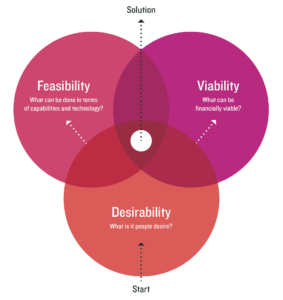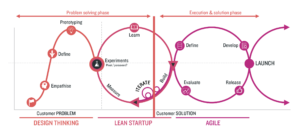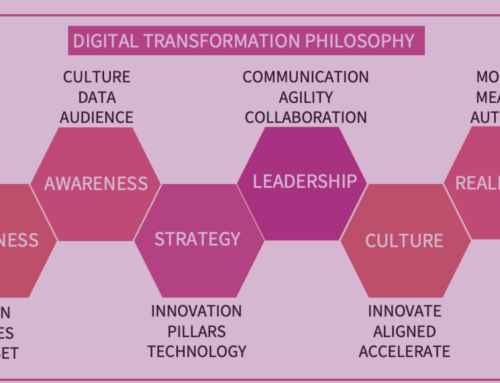Through my leadership training, along with a survey of business leaders, I have found that changing culture is the No.1 driver of digital transformation. The next most important element of change is the acquisition of new talent, to drive forward and future-proof a business. And key to attracting the best new talent is a business culture built on innovation and Design Thinking.
Why is Design Thinking crucial for digital leaders driving through change or transformation in a business?
Design Thinking is a buzzword that you may well have come across. But is it an ideology, a methodology or a philosophy? Whilst you could say it’s all three, it’s actually a problem-solving approach, which allows teams to systematically identify their customers’ issues and generate new opportunities to resolve them.
Think about it. Everything from a product to an experience can be designed to improve its quality for the end-user and reduce waste – to become more sustainable for both the business and the planet. And as customers become ever more savvy and aware that they can get similar, or even identical, products and services elsewhere (for more about this, see my article Digital Sales Strategy in a Customer-Centric World), understanding their specific needs and designing user-centric solutions becomes ever more vital to business growth and sustainability.
So Design Thinking is about solving problems in a user-centric way. It originated as the preserve of the UX team, but embedded across an organisation, Design Thinking can help a business come up with solutions to seemingly unsolvable issues. It draws on a whole team’s imagination, intuition, logic, reasoning and customer knowledge; promoting creativity and fostering a culture of innovation within the organisation.
What is Design Thinking?
Design Thinking came into being as a way of taking the problem-solving methods designers use and applying them to areas designers don’t usually get involved with – like organisational design or business or marketing issues. These areas, though not commonly involving the design team, can be resolved by ‘thinking like a designer’. It’s true; you don’t have to be a designer to think like one, and whilst design skills need to be learned and practiced, Design Thinking draws on critical thinking and problem-solving skills which a professional team should already have in abundance. With a little guidance, everyone in an organisation can adopt design techniques like observing, interviewing, storyboarding and persona building.
This approach helps a business to focus on its customers in all aspects of the business – offering huge value. It involves really getting to know your customers, so that every area of the business operated from a position of empathy with their wants and needs. By fully understanding its customers’ ‘pain points’ a business can be redesigned around effectively meeting those needs at every point of interaction.
How does the Design Thinking process work?
Although the Design Thinking process can be broadly divided into five phases, the first thing to recognise is that it’s not a linear process. A Design Thinking business culture will move backwards and forward, and around the phases – constantly evolving as more is learned about customer needs, and as those needs themselves evolve.
Phase 1 – Empathy
Developing true empathy with your customer involves getting to know and engaging with real people, to understand their needs and relationship with you – from an emotional perspective as well as a practical one. How you do this will depend on the nature of the business and the resources available, but it should ideally include a mix of quantitative data collection and analysis (which the business is hopefully already doing) and reviewing your regular customer feedback, alongside additional qualitative research like focus groups and interviews.
Phase 2 – Definition
Define the problem. Gathering all the insights collected in Phase 1 will allow the business to discover where customers may be coming up against barriers. Are there patterns in behaviour and interactions? Analysing the customer insights will reveal the big problems that the business needs to resolve. Always express that problem from a customer point of view – what is it that THEY want and need?
Phase 3 – Ideas
Once the problem is defined, the team can get to work coming up with ideas for solutions. This is the really creative part, and your Design Thinking workshops can use any number of techniques from brainstorming to storyboarding, role play to mind mapping. Whichever techniques your team uses, you may find it useful to engage someone from outside the business to facilitate this phase – as an objective external perspective often helps to unlock ideas and push beyond the obvious boundaries. Keep an open mind, and don’t discard ideas too soon. Once the team has exhausted the creative possibilities, then it is time to whittle down the ideas into those to be taken through to Phase 4.
Top success tips for idea generation
- encourage the team to look forwards rather than backwards. “This is the way we’ve always done it” is one of the most dangerous phrases in the English language – it kills creativity stone dead!
- go somewhere that inspires thinking, learning and ideas.
- accept uncertainty. More answers will reveal themselves as the process unfolds.
- as ideas arise, allow them out of people’s heads, whether through discussion, mind-mapping or whatever technique is being used. Treat every idea as a tangible thing and don’t block its path, as you never know where it will lead.
Phase 4 – Prototype
In this phase, ideas are put to the test by becoming scaled down versions of a final product or service. Prototyping is crucial in order to stress-test those new products – highlighting any problems or flaws, as well as feasibility and viability.
Phase 5 – Test
This is where the process often becomes non-linear. As the business tests new products or services, it’s common for the results to demand new prototyping, or even a return to Phase 3 to look at new ideas; or to Phase 2, to redefine the problem.
Design Thinking, Lean and Agile
At this point in my 3-day leadership training programme, the question about how Design Thinking, Lean and Agile work together usually pops up.
Now you know what Design Thinking is, and how it works, let’s remind ourselves about ‘Lean’ and ‘Agile’, and look at how the three ideologies work together.
LEAN focusses on streamlining processes as much as possible, to minimise waste and achieve maximum value. It relies on collaboration between several business functions – chiefly design, marketing and management, and involves gathering feedback as you go, so everyone is constantly learning and adapting. LEAN focuses less on long-term deliverables and more on making quick decisions in order to enable rapid delivery. So the whole team needs to be engaged and involved.
AGILE works in incremental cycles, and is flexible and adaptive. In order to get new products and services up and running, it prioritises individuals and interactions over processes and tools, and collaboration and quick response over documentation and a long-term plan.
Whilst Design Thinking, Agile and Lean are often seen by business leaders as three separate approaches – one of the most common questions I get being “which should I use in my business?”.
The answer for a digital leader is, as the graphic above shows, that you should be seeing them as interactive processes which can be merged to achieve optimal results for your business. Applying Design Thinking in an environment which is both lean and agile helps to create a customer-centric development process for new products or services. As an effective leader, ensuring that the teams in your business are combining and applying principles from each methodology helps to promote a truly collaborative culture in which everyone is working to a common vision.
In practice, Design Thinking is your solution-based approach to resolving your customers’ problems – keeping them at the epicentre of the process. Lean principles drive how you test your ideas and gather feedback to see what works, and Agile ties everything into short ‘sprint’ cycles, enabling the process to be fully adaptable as circumstances change. In combination, the three methodologies cut out unnecessary processes and bureaucracy and, with the right level of cross-team collaboration, deliver optimum value to the customer and to the business.
How I’ve used a combination of Design Thinking, Lean and Agile in transforming my business.
I launched my technology company in 2010, and grew it to a £1Million business in less than three years. We used Design Thinking methodology to come up with the idea of launching a unique e-commerce platform; then used the lean approach when building our MVP (minimum viable product). We went to market with the MVP (agile) and did case studies on 20+ businesses achieving good revenue through the platform, which enabled us to secure SEIS seed funding to build a working SAAS module.
Read more about business innovation in my 10 Simple and Effective Business Innovation Success Tips.
Ready to produce game-changing digital results in your business?
Subscribe to receive cutting edge insights on digital leadership and transformation- straight to your inbox
We do not sell or share your information with anyone.











